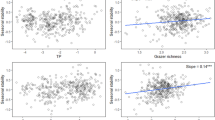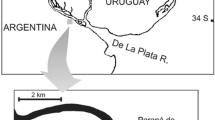Abstract
The aim of this work is to answer some questions like: what factors control the phytoplankton assemblage? What factor or factors are perturbing the assemblage? What factors are driving or maintaining the stability? Are the different responses to the control factors dependent on the hierarchy level? For that, we tested experimentally the influence of herbivory, planktivory, nutrients and sediment on phytoplankton assemblages and its stability from a hypertrophic wetland (Las Tablas de Daimiel National Park, Spain) in three microcosm experiments. The study of the steady state phytoplankton assemblages in this perturbed system could point out some underlying processes instead of competition. The presence of planktivorous fish and the different composition of zooplankton have minor importance in phytoplankton composition. Conversely, sediment is of paramount importance, promoting a more diverse phytoplankton assemblage. When sediment or nutrient pulses are absent, phytoplankton become dominated by slow-growing algae, present but not dominant in the studied wetland community. We suggest that alternate states of phytoplankton assemblages in a eutrophic wetland occur as a sequence of substitutions persistently altered by perturbations, thanks to the close coupling with sediment, and that possibly trophic relationships are irrelevant.
Similar content being viewed by others
References
Álvarez-Cobelas, M. & S. Cirujano (eds), 1996. Las Tablas de Daimiel, Ecología Acuática y Sociedad. Ministerio Español de Medio Ambiente, Madrid. 368 pp.
APHA, AWWA & WPCF, 1985. Standard Methods for the Examination of Water and Wastewater (16th ed.). American Public Health Association, Washington. 1268 pp.
Bachmann, R. W. & D. E. Canfield, 1996. Use of an alternative method for monitoring total nitrogen concentrations in Florida lakes. Hydrobiologia 323: 1–8.
Beklioglu, M. & B. Moss, 1996. Mesocosms experiments on the interaction of sediment influence, fish predation and aquatic plants with the structure of phytoplankton and zooplankton communities. Freshwat. Biol. 36: 315–325.
Berger, C. & A. Bij de Vaate, 1983. Limnological studies on the eutrophication of Lake Wolderwijd. A shallow hypertrophic Oscillatoria dominated lake in the Netherlands. Schweizerische Zeitschrift für Hydrol. 45: 458–479.
Boero, F., G. Belmonte, G. Fanelli, S. Piraino & F. Rubino, 2000. The continuity of living matter and the discontinuities of its constituents: do plankton and benthos really exist? Trends Ecol. Evol. 11: 117–180.
Borics, G., B. Tóthmérész, I. Grigorszky, J. Padisák, G. Várbíró & S. Szabó, 2003. Algal assemblage types of bog-lakes in Hungary and their relation to water chemistry, hydrological conditions and habitat diversity. Hydrobiologia 502 (Dev. Hydrobiol. 172): 145–155.
Carpenter, S., J. F. Kitchell & J. R. Hodgson, 1985. Cascading trophic interactions and lake productivity. BioScience 35: 634–639.
Chow-Fraser, P., 1998. A conceptual ecological model to aid restoration of Cootes Paradise Marsh, a degraded coastal wetland of Lake Ontario, Canada. Wetlands Ecol. Manage. 6: 43––57.
Collins, M., 1978. Algal toxins. Microbiol. Rev. 42: 725–746.
Cottingham, K. L. Nutrients and zooplankton as multiple stressors of phytoplankton communities: evidence from size structure. Limnol. Oceanogr. 44: 810–827.
Guo, M., P. J. Harrison & F. J. Taylor, 1996. Fish kills related to Prymnesium parvum Carter (Haptophyta) in the People's Republic of China. J. Appl. Phycol. 8: 111–117.
Jensen, J. P., E. Jeppesen, K. Olrik & P. Kristensen, 1994. Impact of nutrients and physical factors on the shift from cyanobacterial to chlorophyte dominance in shallow Danish lakes. Can. J. Fish. aquat. Sci. 51: 1692-1699.
Jeppesen, E., 1998. The ecology of shallow lakes. Trophic interactions in the pelagial. Doctor's dissertation (DSc). NERI Technical report No. 247. National Environmental Research Institute, Silkeborg. 358 pp.
Johansson, N. & E. Granéli, 1999. Influence of different nutrient conditions on cell density, chemical composition and toxicity of Prymnesium parvum (Haptophyta) in semi-continuous cultures. J. exp. mar. Biol. Ecol. 239: 243–258.
Klaveness, D., 1988. Ecology of the Cryptomonadina: a first review. In Sandgren C. D. (ed). Growth and Reproductive Strategies of Freshwater Phytoplankton. Cambridge University Press, Cambridge: 105–133.
Komárková, J. & R. Tavera, 2003. Steady state of phytoplankton assemblage in the tropical Lake Catemaco (Mexico). Hydrobiologia 502 (Dev. Hydrobiol. 172): 187–196.
Kurmayer, R. & J. Wanzenböck, 1996. Top-down effects of underyearling fish on a phytoplankton community. Freshwat. Biol. 36: 599–609.
Hansson, L.-R., 1996. Algal recruitment from lake sediments in relation to grazing, sinking, and dominance patterns in the phytoplankton community. Limnol. Oceanogr. 41: 1312-1323.
Lampert W. & U. Sommer, 1997. Limnoecology: the ecology of lakes and streams. Oxford University Press, New York.
Levins, R., 1979. Coexistence in a variable environment. Am. Nat. 114: 765–783.
Lund, J.W. G., C. Kipling & E. D. Le Cren, 1958. The inverted microscope method of estimating algal numbers and the statistical basis of estimations by counting. Hydrobiologia 11: 143–170.
McCauley, E., 1984. The estimation of the abundance and biomass of zooplankton in samples. In Downing, J. A. & F. H. Rigler (eds), A Manual on Methods for the Assessment of Secondary Productivity in Fresh Waters. Blackwell Scientific Publications, Oxford: 228–265.
Marcus, N. H. & F. Boero, 1998. Minireview: the importance of benthic-pelagic coupling and the forgotten role of life cycles in coastal aquatic systems. Limnol. Oceanogr. 43: 763–768.
Olrik, K., 1994. Phytoplankton ecology. Miljøministeriet, København. 183 pp.
Ortega-Mayagoitia, E. & C. Rojo, 2000. Fitoplancton del Parque Nacional Las Tablas de Daimiel. II. Las cianofíceas, los dinoflagelados, las criptofíceas, las crisofíceas y las xantofíceas. Anales del Jardín Botánico de Madrid 57: 251–266.
Ortega-Mayagoitia, E. & C. Rojo, 2000. Fitoplancton del Parque Nacional de Las Tablas de Daimiel. III. Las diatomeas y las clorofíceas. Anales del Jardín Botánico de Madrid 58: 17–37.
Ortega-Mayagoitia, E., X. Armengol & C. Rojo, 2000. Zooplankton structure and dynamics in a semiarid wetland, the National Park “Las Tablas de Daimiel” (Spain). Wetlands 24: 629–638.
Ortega-Mayagoitia, E., M. A. Rodrigo & C. Rojo, 2002. Factors masking the trophic cascade in shallow eutrophic wetlands: evidence from a microcosm study. Archiv für Hydrobiol. 155: 43–63.
Padisák, J., G. Borics, G. Fehér, I. Grigorszky, I. Oldal, A. Schmidt & Z. Zámbóné-Doma, 2003. Dominant species, functional assemblages and frequency of equilibrium phases in late summer phytoplankton assemblages in Hungarian small shallow lakes. Hydrobiologia 502 (Dev. Hydrobiol. 172): 157–168.
Reynolds, C. S., 1984. The ecology of freshwater phytoplankton. Cambridge University Press, Cambridge. 384 pp.
Reynolds, C. S., 1988. Functional morphology and the adaptive strategies of freshwater phytoplankton. In Sandgren C. D. (ed.), Growth and Reproductive Strategies of Freshwater Phytoplankton. Cambridge University Press, Cambridge: 388–433.
Reynolds, C. S., 1993. Scales of disturbance and their role in plankton ecology. Hydrobiologia 249: 157–171.
Reynolds, C. S., 1997. Vegetation processes in the pelagic: a model for ecosystem theory. Ecology Institute, Oldendorf-Luhe. 371 pp.
Reynolds, C. S., J. Padisák & U. Sommer, 1993. Intermediate disturbance in the ecology of phytoplankton and the maintenance of species diversity: a synthesis. Hydrobiologia 249: 183–188.
Rojo, C. & M. Álvarez-Cobelas, 1993. Population dynamics of Limnothrix redekei, Oscillatoria lanceaeformis, Planktothrix agardhii and Pseudanabaena limnetica (Cyanobacteria) in a shallow hypertrophic lake (Spain). Hydrobiologia 275/276: 165–171.
Rojo, C. & M. Álvarez-Cobelas, 2001. Phytoplankton structure and dynamics at a daily temporal scale: response to the thermal overturn. Archiv für Hydrobiol. 151: 549–569.
Rojo, C., E. Ortega-Mayagoitia & V. Conforti, 1999. Fitoplancton del Parque Nacional de las Tablas de Daimiel. I. Las Euglenofitas. Anales del Jardín Botánico de Madrid 57: 15–23.
Rojo, C., E. Ortega-Mayagoitia, M. Álvarez-Cobelas & M. A. Rodrigo, 2000a. Phytoplankton structure and dynamics in a semiarid wetland, the National Park “Las Tablas de Daimiel” (Spain). Archiv für Hydrobiol. 148: 397–419.
Rojo, C., E. Ortega-Mayagoitia & M. Álvarez-Cobelas, 2000b. Lack of pattern among phytoplankton assemblages. Or, what does the exception to the rule mean? Hydrobiologia 424: 133–139.
Rojo, C. & M. Álvarez-Cobelas, 2003. Are there steady-state phytoplankton assemblages in the field? Hydrobiologia 502 (Dev. Hydrobiol. 172): 3–12.
Rothhaupt, K. O., 1990. Resource competition of herbivorous zooplankton: a review of approaches and perspectives. Archiv für Hydrobiol. 118: 1–29.
Rott, E., 1981. Some results from phytoplankton counting intercalibrations. Schweizerische Zeitschrift für Hydrol. 43: 34–62.
Sánchez-Carrillo, S. & M. Álvarez-Cobelas, 2001. Nutrient dynamics and eutrophication patterns in a semi-arid wetland: the effects of fluctuating hydrology. Wat. Air Soil Pollut. 127: 12–27.
Stephen, D., B. Moss & G. Phillips, 1998. The relative importance of top-down and bottom-up control of phytoplankton in a shallow macrophyte-dominated lake. Freshwat. Biol. 39: 699–713.
Sommer, U., 1985. Comparison between steady state and nonsteady state competition: experiments with natural phytoplankton. Limnol. Oceanogr. 30: 335–346.
Sommer, U., M. Z. Gliwicz, W. Lampert & A. Duncan, 1986. The PEG-model of seasonal succession of planktonic events in fresh waters. Archiv für Hydrobiol. 106: 433–471.
Underwood, A. J., 1997. Experiments in ecology: their logical design and interpretation using analysis of variance. Cambridge University Press, Cambridge. 504 pp.
von Ende, C. N., 1993. Repeated measures analysis: growth and other time-dependent measures. In Scheider, S. M. & J. Gurevitch (eds), Design and Analysis of Ecological Experiments. Chapman and Hall, New York: 113–137.
Author information
Authors and Affiliations
Rights and permissions
About this article
Cite this article
Ortega-Mayagoitia, E., Rojo, C. & Rodrigo, M.A. Controlling factors of phytoplankton assemblages in wetlands: an experimental approach. Hydrobiologia 502, 177–186 (2003). https://doi.org/10.1023/B:HYDR.0000004280.74279.74
Issue Date:
DOI: https://doi.org/10.1023/B:HYDR.0000004280.74279.74




